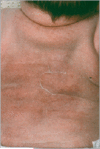Expression of 25-hydroxyvitamin D3-1alpha-hydroxylase in subcutaneous fat necrosis
- PMID: 18811689
- PMCID: PMC2678231
- DOI: 10.1111/j.1365-2133.2008.08844.x
Expression of 25-hydroxyvitamin D3-1alpha-hydroxylase in subcutaneous fat necrosis
Abstract
Background: The most serious complication of subcutaneous fat necrosis (SCFN), a rare condition of the newborn characterized by indurated purple nodules, is hypercalcaemia. However, the mechanism for this hypercalcaemia remains unclear.
Objectives: To determine whether the hypercalcaemia associated with SCFN involves expression of the vitamin D-activating enzyme 25-hydroxyvitamin D(3)-1alpha-hydroxylase (1alpha-hydroxylase) in affected tissue.
Methods: Skin biopsies from two male patients with SCFN and hypercalcaemia were taken. The histological specimens were assessed using a polyclonal antibody against 1alpha-hydroxylase.
Results: Histology in both cases showed strong expression of 1alpha-hydroxylase protein (brown staining) within the inflammatory infiltrate associated with SCFN. This was consistent with similar experiments in other granulomatous conditions.
Conclusions: Hypercalcaemia in SCFN appears to be due to abundant levels of 1alpha-hydroxylase in immune infiltrates associated with tissue lesions. This is consistent with previous observations of extrarenal 1alpha-hydroxylase in skin from other granulomatous conditions such as sarcoidosis and slack skin disease.
Figures


References
-
- Kruse K, Irle U, Uhlig R. Elevated 1,25-dihydroxyvitamin D serum concentrations in infants with subcutaneous fat necrosis. J Pediatr. 1993;122:460–3. - PubMed
-
- Finne PH, Sanderud J, Aksnes L, et al. Hypercalcaemia with increased and unregulated 1,25-dihydroxyvitamin D production in a neonate with subcutaneous fat necrosis. J Pediatr. 1988;112:792–4. - PubMed
-
- Alos N, Eugene D, Fillion M, et al. Pamidronate: treatment for severe hypercalcemia in neonatal subcutaneous fat necrosis. Horm Res. 2006;65:289–94. - PubMed
-
- Zehnder D, Bland R, Walker EA, et al. Expression of 25-hydroxyvitamin D3–1α-hydroxylase in the human kidney. J Am Soc Nephrol. 1999;10:2465–73. - PubMed
Publication types
MeSH terms
Substances
Grants and funding
LinkOut - more resources
Full Text Sources
Medical

